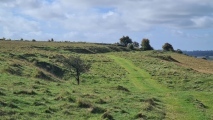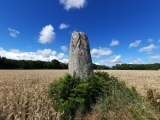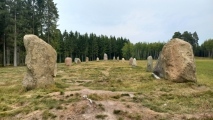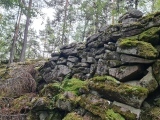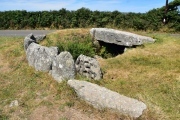Andy Burnham's Blog, page 127
October 8, 2022
Whitesheet Hill
An extensive site just to the north of the town of Mere, Wiltshire and visible from the A303. It comprises a neolithic causewayed camp, a series of Bronze Age barrows and a large Iron Age hill fort. Also present is a cold-war Royal Observer Corp bunker. Neolithic enclosures of this type are quite rare - their distinctive feature being the interruptions or causeways crossing the ditch at numerous intervals.
Published on October 08, 2022 09:18
October 7, 2022
Menhir de Kerlagad (Carnac)
Published on October 07, 2022 10:13
October 6, 2022
3rd Stone Issue 46, Spring 2003 for Free Download
In this issue:
Caught Knapping: The Strange Career of Flint Jack - Robert Halliday describes the life of a once-notorious Victorian forger of prehistoric artefacts
Wassail! The origins of a drinking toast - Richard Sermon
Stones of Power - Raised in Magic Hour - Robert Farrah considers the folktales surrounding some prehistoric monuments and the dire consequences for those who would disturb these ancient places
Bridestones Revisited: Uncovering one of England's Best-Kept Neolithic Secrets - Paul and Vicky Morgan describe a once-mighty megalithic site in Cheshire, a county where the prehistory is rarely monumental
Sacred Preseli - David Kaiser considers aspects of the Preseli Mountains that may have led to the peaks being considered sacred in antiquity, and how this relates to the Stonehenge bluestones
The World Turned Upside Down Stonehenge Summer Solstice Before the Hippies - Notorious as it was, the Free Festival wasn't the first time people had assembled at Stonehenge in modern times. Adam Stout revisits earlier midsummer gatherings at the stones - and more...
Caught Knapping: The Strange Career of Flint Jack - Robert Halliday describes the life of a once-notorious Victorian forger of prehistoric artefacts
Wassail! The origins of a drinking toast - Richard Sermon
Stones of Power - Raised in Magic Hour - Robert Farrah considers the folktales surrounding some prehistoric monuments and the dire consequences for those who would disturb these ancient places
Bridestones Revisited: Uncovering one of England's Best-Kept Neolithic Secrets - Paul and Vicky Morgan describe a once-mighty megalithic site in Cheshire, a county where the prehistory is rarely monumental
Sacred Preseli - David Kaiser considers aspects of the Preseli Mountains that may have led to the peaks being considered sacred in antiquity, and how this relates to the Stonehenge bluestones
The World Turned Upside Down Stonehenge Summer Solstice Before the Hippies - Notorious as it was, the Free Festival wasn't the first time people had assembled at Stonehenge in modern times. Adam Stout revisits earlier midsummer gatherings at the stones - and more...
Published on October 06, 2022 02:41
October 5, 2022
Høj Stene
According to the new excavations and finds, the former ship setting of Vejerslev ("Høj Stene") is dated to around 600 AD and is therefore late Iron Age in Denmark and not Viking Age. According to more recent information on the investigations into the ship setting, it may be the oldest royal tomb in Denmark. Remarkable gold finds show that the ship setting framed a cremation grave again from the late Danish Iron Age (550-750 AD).
Published on October 05, 2022 09:09
October 4, 2022
Unhenged
Sonia Watson on the BBC Radio Essex breakfast show interviews Joe McNamara who built the Stonehenge replica near Brentwood, Essex, listen via the comments on our page. A huge concrete replica Stonehenge in Brentwood can stay for at least 18 months giving its creator time to enter it into the prestigious Turner Prize art competition. Joe McNamara says he built the huge structure as a warning against the perils of climate change.
Published on October 04, 2022 03:51
October 3, 2022
Andorsrud
Andorsrud hillfort is located on a high rocky hill covered in forest overlooking the small lake Løken to the south. To get there visitors have to park down by a local road and walk along the road to the last farm. From there it is a footpath leading west on the north side of the lake before turning north and making a turn to the south to get up on the fort. The hill is surrounded almost completely by a wall except on the east side where the hill is very steep. The hill has two natural plateaus with the highest on to the north. The hillfort has very little damage except the natural moss growth and the walls are very well preserved.
Published on October 03, 2022 11:59
October 1, 2022
Tregiffian Barrow
The Tregiffian project picks up work on an unpublished excavation, including photogrammetry of the rock art, more in the comments on our page. A Neolithic or early Bronze Age chambered tomb by the side of a country road near to the Merry Maidens, which has a stone near the entrance decorated with numerous cup marks. This circular barrow, located just down the road from the Merry Maidens consists of a burial chamber composed of stone uprights, dry stone walling and 4 capstones. The northern half has been obliterated by the modern road.
Published on October 01, 2022 07:47
Northern Earth Issue 169 Out Now
In this issue: Gone to Earth - A fox deployed its cunning for 300 years at a farm
near Leeds
Bishop Gundulfs Tears - Simon Crook considers the Coldrum Ley and
the lamentation of the landscape
Apocryphal gods over Mersey -Rumours of spirits take Andrew Mitchell out in the
Wirral bush
Number and Measure at the Buizegem-Edegem Circles - John Palmer investigates the geomancy of ancient Netherlands
Having Your Say - Reader input on river loops and propped stones
All Things Considered: Reviews - Books on sacred and forgotten places and what they
are known by, and rituals unmasked
Northern Folk - A new venture celebrates northern cultural tradition
Seasons Gleanings - Archaeology, folklore and absurdity from around
the world
Mike Haighs Archaeology Review - Mikes round-up includes ancient weights, flayed
Vikings, recycled protection, and Stonehenges ancient landscape
near Leeds
Bishop Gundulfs Tears - Simon Crook considers the Coldrum Ley and
the lamentation of the landscape
Apocryphal gods over Mersey -Rumours of spirits take Andrew Mitchell out in the
Wirral bush
Number and Measure at the Buizegem-Edegem Circles - John Palmer investigates the geomancy of ancient Netherlands
Having Your Say - Reader input on river loops and propped stones
All Things Considered: Reviews - Books on sacred and forgotten places and what they
are known by, and rituals unmasked
Northern Folk - A new venture celebrates northern cultural tradition
Seasons Gleanings - Archaeology, folklore and absurdity from around
the world
Mike Haighs Archaeology Review - Mikes round-up includes ancient weights, flayed
Vikings, recycled protection, and Stonehenges ancient landscape
Published on October 01, 2022 07:31
September 29, 2022
Nordre-Hovum/Hovtun
This barrow cemetery consists of seven round barrows. Four of them are located on a hill oriented in a semi-circle surrounding a local house and two more in the garden of another house around 100 metres to the west.
The barrows on the hill follow the edge of the hill to the west and south-west. Some of the barrows have been built on natural rock outcrops probably to make them look bigger than they actually are. They are all covered in large trees, grass and small bushes but the closest barrow to the road is easy visible. It is a large round barrow with a very pretty shape. It is around 20 metres in diameter and 2 metres in height.
The barrows on the hill follow the edge of the hill to the west and south-west. Some of the barrows have been built on natural rock outcrops probably to make them look bigger than they actually are. They are all covered in large trees, grass and small bushes but the closest barrow to the road is easy visible. It is a large round barrow with a very pretty shape. It is around 20 metres in diameter and 2 metres in height.
Published on September 29, 2022 06:49
September 27, 2022
Museum Silkeborg
One of Denmark's top cultural history museums, located at three different sites: Manor House (Hovedgården), the Paper Mill Museum (Papirmuseet) in Silkeborg and Blicheregnen farm in the village of Thorning. Exhibitions cover the Stone Age, the Bronze Age, the Iron Age and the Viking Age. One of the best preserved bog bodies is on display: a Pre-Roman Iron Age man, world famous under the name 'Tollund Man'. Photos of him are on our page.
The Rittmeister Hans Nicolai Hoff built Silkeborg Hovedgård between 1767 and 1770 after he had acquired Silkeborg Castle, whose buildings had fallen into despair. In 1846 the premises were briefly used as a chapel (for workers at the nearby paper mill). It was even used as a post office afterwards. The museum was founded in 1904. After falling back into private hands, the museum became state owned again in 1939.
The Rittmeister Hans Nicolai Hoff built Silkeborg Hovedgård between 1767 and 1770 after he had acquired Silkeborg Castle, whose buildings had fallen into despair. In 1846 the premises were briefly used as a chapel (for workers at the nearby paper mill). It was even used as a post office afterwards. The museum was founded in 1904. After falling back into private hands, the museum became state owned again in 1939.
Published on September 27, 2022 09:37

